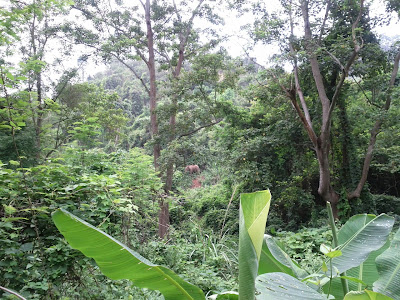Our field staffs at Lampang Camp release2 kind of fishes (Common carp fish and silver barb fish ) in Pool 3 and they meet a group of elephants (Pang Dokrak, Pang Kanya, Pang Sunee and Pang Dongdao) at the pool too.
Our Mission is to realize the vision of Her Majesty Queen Sirikit, The Queen Mother by reintroducing domesticated elephants into the wild, restoring wild habitats with indigenous plants and wildlife, researching and propagating knowledge about elephants and promoting appropriate management of elephants in Thailand for their long-term survival.
Thursday, April 28, 2011
Preparing Spa with fishes for Elephants
เจ้าหน้าที่ภาคสนามนำปลาตะเพียน และปลาไน มาปล่อยในบริเวณสระ 2 เนื่องจากปลาเหล่านี้กินพืชน้ำเป็นอาหาร และช่วยกำจัดจอก แหน ที่ขึ้นอยู่ตามบริเวณผิวน้ำ
ปลาไน และ ปลาตะเพียน
The Common carp (Cyprinus carpio) is a widespread freshwater fish of eutrophic waters in lakes and large rivers in Europe and Asia.
Wild common carp are typically slimmer forms, with body length about four times body height .They can eat a vegetarian diet of water plants.
ปลาไน หรือที่นิยมเรียกกันว่า ปลาคาร์ป เป็น ปลาน้ำจืดชนิดหนึ่ง ชื่อวิทยาศาสตร์ ว่า Cyprinus carpio อยู่ในวงศ์ปลาตะเพียน (Cyprinidae) เป็นปลาที่มีรูปร่างป้อม แบนข้างเล็กน้อย ส่วนหัวลาด ปากมีขนาดเล็ก มีหนวดสั้น 2 คู่ ครีบหลังค่อนข้างยาว ครีบหางเป็นเว้าแฉกลึก สีลำตัวมีสีน้ำตาลคล้ำอมทองหรือน้ำตาลอ่อน ท้องสีจาง บางตัวอาจมีสีสัน ปลาตัวผู้ในฤดูผสมพันธุ์จะมีตุ่มสิวขึ้นบริเวณใบหน้า และครีบอก ผสมพันธุ์และวางไข่ได้ทุกฤดูโดยวางติดกับพืชน้ำ ปลาไนเลี้ยงง่าย เพราะเป็นปลาที่กินอาหารตามธรรมชาติ ได้แก่ จุลินทรีย์ในน้ำ ลูกน้ำ แหนเป็ด ไข่น้ำ รากและใบผักบุ้ง ผักแพงพวย ลูกกุ้ง ลูกหอย แต่ถ้าให้รำ หนอน และแมลงเพิ่มเติมจะทำให้โตเร็วขึ้น
The silver barb (Barbonymus gonionotus) is a freshwater fish species in the minnows or carps family (family Cyprinidae) of order Cypriniformes (carps),. (http://www.fishthailand.co.uk/species/silver_barb.html). Body is strongly compressed. The back is elevated, its dorsal profile arched, often concave above the occiput. The head is small; the snout pointed; the mouth terminal. The barbels are very minute or rudimentary, especially the upper ones, which sometimes disappear entirely. Color when fresh is silvery white, sometimes with a golden tint. The dorsal and caudal fins are gray to gray-yellow; the anal and pelvic fins light orange, their tips reddish; the pectoral fins pale to light yellow. they eat water plant./(www.fishbase.org).
ปลาตะเพียน เป็นชื่อปลาน้ำจืดชนิดหนึ่ง ชื่อวิทยาศาสตร์ ว่า Barbonymus gonionotus อยู่ในวงศ์ปลาตะเพียน มีรูปร่างเหมือนปลาในตระกูลปลาตะเพียนทั่วไป ตัวมีสีเงินแวววาว ด้านหลังมีสีคล้ำเล็กน้อย ด้านท้องสีจาง ครีบอื่น ๆ มีสีเหลืองอ่อน นิสัยการกิน กล่าวกันว่าลูกปลาตะเพียนวัยอ่อน กินสาหร่ายเซลล์เดียวและแพลงก์ตอนขนาดเล็ก ส่วนพวกปลาขนาด 3 - 5 นิ้ว กินพวกพืชน้ำ เช่น แหนเป็ด สาหร่ายพุงชะโด ผักบุ้ง สำหรับปลาขนาด ใหญ่สามารถกินใบพืชบก เช่น ใบมันเทศ ใบมันสำปะหลัง หญ้าขน ฯลฯSunday, April 24, 2011
Plai Chalard
The naughty juvenile elephant is laughing in the forest clearing because he has been shot with two tranquilizer darts but still won't fall asleep! พลายฉลาดช้างหนุ่มในป่าซับลังกา กำลังหัวเราะอยู่ในป่า เมื่อลูกดอกยาสลบ 2 ดอก ไม่สามารถทำให้เขาง่วงซึมได้
Published with Blogger-droid v1.6.7
Mor Taweepoke

Mor Thom is very tired after driving from Lampang to Sublangka since 3 AM and then chasing after Plai Chalard for hours.หมอต้อม นายสัตวแพทย์ที่ปรึกษาของมูลนิธิฯ เหนื่อยจากการเดินทางจากลำปาง โดยมาถึงยังซับลังกาประมาณ ตี3 จากนั้นต้องมาตามจับพลายฉลาดต่ออีกหลายชั่วโมง
Published with Blogger-droid v1.6.7
Chonsaporn in Camouflage
Jim wears camouflage to hide from Plai Chalard. ชลษพร (จิม) สวมผ้าพรางตัว เพื่อพรางตาพลายฉลาดไว้ไม่ให้เห็นตัวเธอ
Published with Blogger-droid v1.6.7
Sublangka forest ranger.
Shows the holy or good luck markings on the elephant tranquilizer rifle.เจ้าหน้าที่ป่าไม้ซับลังกา โชว์เครื่องรางที่อยู่กับปืนยิงยาซึมช้าง
Published with Blogger-droid v1.6.7
Friday, April 22, 2011
Professors of Mathematics Department, Faculty of Science, Chiang Mai University give an advice about Face Recognition Program (A program that will help us to recognise elephant's face). The conclusion of this meeting was it got a chance to do by specialist.
ทางคณะอาจารย์จากภาควิชาคณิตศาสตร์ คณะวิทยาศาสตร์ มหาวิทยาลัยเชียงใหม่ เข้ามาให้คำปรึกษาในเรื่องแนวทางการศึกษา Face Recognition ในช้าง ร่วมกับทางมูลนิธิคืนช้างสู่ธรรมชาติ โดยมีข้อสรุปว่ามีความเป็นไปได้ที่จะจัดทำโปรแกรมขึ้นทั้งนี้ต้องอาศัยผู้เชี่ยวชาญเฉพาะ
Eye Hurt
Assist. Prof. Chatchote Thitaram DVM, consulting veterinarian of the Foundation (Mor Bic) and student from faculty of veterinary medicine, Chiangmai University visit to check Pang Tukta's eye.
นายสัตวแพทย์ฉัตรโชติ ฑิตาราม สัตวแพทย์สถาบันคชบาลแห่งชาติ และนักศึกษาคณะสัตวแพทย์ศาสตร์ เข้ามาดูอาการของพังตุ๊กตาที่มีอาการตาอักเสบติดเชื้อเนื่องจากโดนแทงจากกิ่งไม้
ภาพถ่ายระยะใกล้ๆ ตาขวาของพังตุ๊กตา
หลังจากที่ดูอาการของพังตุ๊กตาแล้วยังไม่มีอาการดีขึ้น จึงเคลื่อนย้ายพังตุ๊กตาเข้ามารักษาอาการที่โรงพยาบาลช้าง สถาบันคชบาลแห่งชาติ
ภาพถ่ายระยะใกล้ๆ ตาขวาของพังตุ๊กตา
หลังจากที่ดูอาการของพังตุ๊กตาแล้วยังไม่มีอาการดีขึ้น จึงเคลื่อนย้ายพังตุ๊กตาเข้ามารักษาอาการที่โรงพยาบาลช้าง สถาบันคชบาลแห่งชาติ
Wednesday, April 20, 2011
Falcon
Our field staff at Lopburi found a falcon under the tree while they are tracking elephants in the forest. เจ้าหน้าที่ภาคสนามลพบุรีออกติดตามช้างได้พบเหยี่ยวหลับกลางวันอยู่พื้นดินใต้ต้นไม้ขนาดถ่ายรูปแล้วยังไม่ตื่นหนีไปไหน
In the project of "Increase Elephant to Create the Forest" The Foundation at Lampang Camp let Pang Tukta to breed with male breeder. For this reason our field staff have to move her adoptive daughter (Pang Dongdao) to live with other elephants for a while. In the picture, Pang Dongdao can get along well with the group (Pang Sunee, Pang Dokrak and Pang Kanya)
ตามโครงการ "เพิ่มช้างสร้างป่า" ที่ต้องการนำพังตุ๊กตาไปผสมพันธุ์กับพ่อพันธุ์ เจ้าหน้าที่ภาคสนามจึงแยกพังดวงดาว(ลูก) ออกจากพังตุ๊กตา(พังตุ๊กตาคือแม่รับของพังดวงดาว) โดยให้พังดวงดาวเข้าไปรวมกลุ่มกับพังสุนีย์ พังดอกรัก พังกันยา ซึ่งพังดวงดาวก็สามารถรวมกลุ่มเข้ากันได้ดีกับกลุ่ม
Monday, April 18, 2011
Our field staff found Pang Boonmee lives alone at Huy Ngo Creek (snake creek). As formerly, Pang Boonmee group with other elephants (Pang Malai, Pang Sarah, Pang pangsa, Pang Phetchara, Plai Mitri, Plai Boriboon and Plai Phalang) in Doi Phamaung Forest.
จากการติดตามช้างในป่า ในช่วงต้นเดือนเมษายน เจ้าหน้าที่ภาคสนามได้พบกับพังบุญมี อาศัยอยู่ลำพังตัวเดียวบริเวณลำห้วยงู ซึ่งเดิมพังบุญมีรวมกลุ่มกับพังมาลัย พังซาร่า พังพรรษา พังเพชรา พลายบริบูรณ์ พลายไมตรี พลายพลัง
Saturday, April 16, 2011


Every 15 days our field staffs at Nong Nooch Tropical Garden take Pang Pompam photo to collect and observe variation of elephant breast after breeding.
ทุกๆ 15 วัน เจ้าหน้าที่ภาคสนามมูลนิธิฯ ประจำสวนนงนุชจะถ่ายภาพเต้านมของพังป๋อมแป๋มเพื่อเก็บเป็นข้อมูลและติดตามดูว่า จะมีการเปลี่ยนแปลงหรือไม่หลังจากที่พังป๋อมแป๋มได้ผสมพันธุ์กับพลายเบริด์
Friday, April 15, 2011
Thursday, April 14, 2011
Monday, April 11, 2011
พิธีแถลงความร่วมมือ มูลนิธิคืนช้าง-สวนนงนุช


Dr. Sumet Tantivejkul, Chairman of Elephant Reintroduction Foundation and Khun Kampon Tansacha, Managing Director of Nong Nooch Tropocal Garden announce cooperation between The Foundation and Nong Nooch Tropical Garden in the project of " Increase Elephant to Created the Forest". Khun Chaichan Aiemjaroenม chief of Sattahip District joins the ceremony to be a witness at Nong Nooch Tropical Garden, on April 11, 2011.
ดร.สุเมธ ตันติเวชกุล ประธานมูลนิธิคืนช้างสู่ธรรมชาติ และนายกัมพล ตันสัจจา ผู้อำนวยการสวนนงนุช ได้แถลงข่าวความร่วมมือระหว่างมูลนิธิคืนช้างสู่ธรรมชาติและสวนนงนุชตาม "โครงการเพิ่มช้าง สร้างป่า" โดยมีนายชายชาญ เอี่ยมเจริญ นายอำเภอสัตหีบ ร่วมเป็นสักขีพยาน เมื่อวันที่ 11 เมษายน พ.ศ. 2554 ณ สวนนงนุชพัทยา
Saturday, April 09, 2011
Friday, April 08, 2011
New Mate
After our veterinarian has checked hormone levels of Pang Tukta (female elephant at Lampang) to indicate estrous cycle for breeding program. At the present, the level is high, our team of veterinarian and field staffs let Plai Tadeang (Plai Red Eye),a 34-years-old bull elephant of National Elephant Institute to breed with Pang Tukta.
หลังจากที่นำสีดอตาแดง อายุ 34 ปี ช้างเพศผู้ที่ทางสถาบันคชบาลแห่งชาติ นำมาเป็นพ่อพันธุ์ มีความชอบพอพังตุ๊กตา ช้างของมูลนิธิฯ ทางสัตวแพทย์ได้ทำการเก็บเลือดพังตุ๊กตาเพื่อตรวจดูฮอร์โมนการเป็นสัด โดยระยะนี้พังตุ๊กตามีค่าฮอร์โมนสูงเหมาะแก่การผสมพันธุ์ หลังจากที่ได้พบกับสีดอตาแดงและได้มีการเล้าโลมสักพักสีดอตาแดงก็ได้ขึ้นทับพังตุ๊กตาจนสำเร็จ
Subscribe to:
Posts (Atom)





























